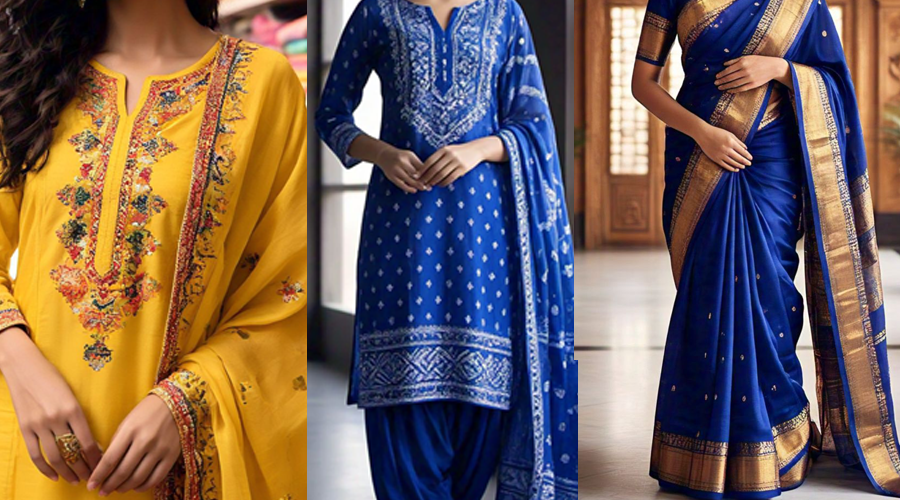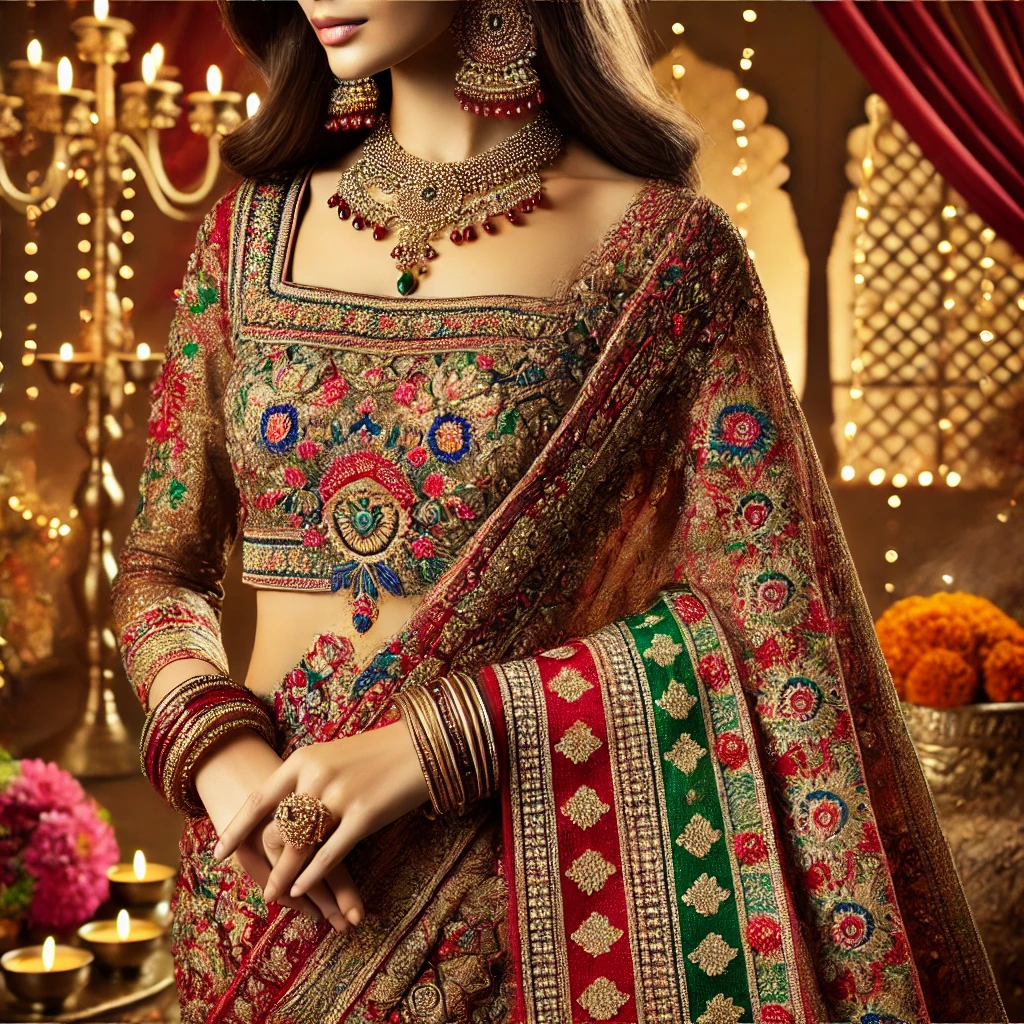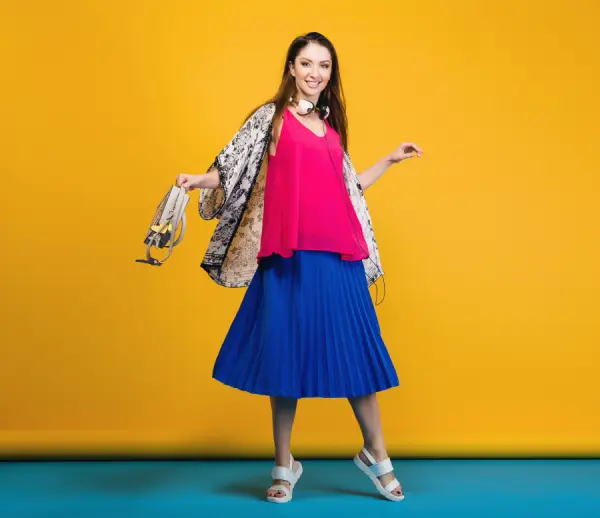
Indian festivals are vibrant celebrations that reflect the country's rich cultural heritage and diversity. One of the most significant aspects of these festivals is the traditional attire worn by individuals, which symbolizes not only personal identity but also community values and regional pride. The significance of traditional dresses during Indian festivals goes beyond mere aesthetics; they serve as a representation of the myriad cultures that coexist within India. Each region of India boasts its unique styles, fabrics, and embellishments, showcasing the diverse traditions that have evolved over centuries. For example, the colorful lehengas of Rajasthan, adorned with intricate mirror work and embroidery, stand in stark contrast to the elegant Kanjeevaram sarees of Tamil Nadu, known for their rich silk and gold borders. This regional variation in attire not only highlights the local craftsmanship but also fosters a sense of belonging and pride among those who wear them. During festivals such as Diwali, Eid, Durga Puja, and Pongal, traditional dresses take center stage as people come together to celebrate. The choice of attire often reflects the festive spirit, with families donning their finest clothes, which are often specially tailored or purchased for the occasion. These garments, imbued with vibrant colors and intricate designs, signify joy and the collective celebration of cultural heritage. Moreover, traditional dresses also serve as a bridge between generations, as families pass down heirloom garments that carry stories and memories. This practice not only preserves the artistry of traditional crafts but also strengthens familial bonds, making festivals a time of both remembrance and celebration. Thus, Indian festival dresses are not just clothing; they are an integral part of the cultural tapestry that embodies the diversity and spirit of India. Historical Significance
Popular Festival Dresses for Women

When it comes to festival fashion, women in India embrace a stunning array of traditional dresses that reflect both cultural heritage and personal style. Among the most popular choices are sarees, lehengas, salwar kameez, and fusion wear, each holding a special place in the celebration of significant festivals like Diwali, Eid, and Durga Puja. Sarees are a timeless classic that epitomizes grace and elegance. Made from various materials such as silk, cotton, and chiffon, sarees come in an endless array of colors and patterns. For Diwali, vibrant hues like deep reds and golds are favored, often embellished with intricate zari work or sequins to symbolize prosperity and light. During Eid, lighter fabrics with delicate embroidery or pastel shades are popular, reflecting the festive mood of the occasion. Lehengas, typically worn with a choli (blouse) and dupatta (scarf), are another favorite during festivals. These three-piece ensembles are often made from luxurious fabrics like velvet or silk and adorned with heavy embroidery or mirror work, especially in colors like royal blue and emerald green. Lehengas are particularly prominent during Durga Puja, where bold colors and intricate designs celebrate the goddess's strength and femininity. The salwar kameez is a versatile garment that combines a long tunic with loose-fitting trousers, often paired with a matching dupatta. Commonly worn during festivals, this attire can be styled in various ways, from simple cotton sets for daytime celebrations to richly embroidered versions for evening festivities. Fabrics such as georgette and chiffon are often chosen for their drape and comfort, with bright colors symbolizing joy and festivity. Finally, fusion wear has gained popularity, blending traditional elements with contemporary styles. This may include modern cuts, asymmetrical hemlines, or western silhouettes combined with ethnic prints or embroidery. Fusion wear allows women to express their individuality while still honoring cultural roots, making it a popular choice for multi-day festivals that require both style and practicality. Overall, the variety in festival dresses reflects the rich tapestry of Indian culture, with each piece telling its own story through fabric, color, and design.
Regional Variations in Festival Attire

India’s diverse cultural landscape is vividly reflected in the attire worn during festivals, with each region showcasing distinct styles, colors, and fabrics that are deeply intertwined with local traditions. From the colorful turbans of Punjab to the elegant sarees of Tamil Nadu, the festival attire across different states offers a glimpse into the rich tapestry of Indian heritage. In Punjab, the festival of Baisakhi is celebrated with great enthusiasm, and the traditional attire reflects this vibrancy. Men often don the kurta paired with a lungi or churidars, while women wear salwar suits with intricate embroidery. The use of bright colors such as yellow and orange, often complemented by traditional accessories like phulkari dupattas, symbolizes the bountiful harvest and the festive spirit of the region. Traveling west to Gujarat, the Navratri festival sees a unique celebration of dance and culture, prominently featuring the chaniya choli for women. This outfit consists of a colorful skirt adorned with mirror work and a matching blouse, paired with a vibrant dupatta. Men typically wear kediyu (a short kurta) and dhoti or churidars. The bright hues and intricate designs reflect the artistic spirit of the state, as participants engage in traditional garba dances throughout the night. In the eastern state of West Bengal, Durga Puja is a time of grand celebration, with women often adorned in sarees, particularly the traditional tant or baluchari sarees, known for their exquisite craftsmanship and vibrant colors. These sarees are often paired with elaborate gold jewelry, enhancing the festive look. Men, on the other hand, may choose to wear punjabi with dhoti, embodying the regional essence during the festivities. Down south in Tamil Nadu, the festival of Pongal showcases the elegance of the Kanjeevaram saree for women, renowned for its rich silk and intricate borders. The sarees are often complemented with traditional temple jewelry. Men typically wear veshti (a type of dhoti) along with a kurta or safari suit, with colors like white and gold being particularly favored to signify purity and celebration. These regional variations in festival attire not only highlight the unique cultural identities of each state but also celebrate the collective spirit of India, where festivals bring together families and communities in joyful harmony.
Modern Trends in Festival Clothing

As festival celebrations evolve, so too does the fashion associated with them. Contemporary trends in festival clothing reflect a dynamic interplay between traditional aesthetics and modern sensibilities, heavily influenced by contemporary fashion designers who are reimagining how festival attire is perceived and worn. This blend of old and new is particularly evident as designers incorporate sustainable practices and innovative fabrics into their creations. One significant trend is the increasing emphasis on sustainable fabrics. With the growing awareness of environmental issues, many designers are turning to eco-friendly materials such as organic cotton, bamboo, and recycled textiles. These fabrics not only reduce the carbon footprint but also appeal to the environmentally conscious consumer who seeks to make ethical choices without compromising on style. As festivals often involve significant gatherings, the impact of clothing choices on the environment has become a focal point for many. The revival of traditional handloom techniques is another modern trend, allowing artisans to showcase their skills while providing consumers with unique pieces. Designers are now collaborating with local weavers to produce garments that celebrate cultural heritage while featuring contemporary cuts and styles. This partnership not only supports local craftsmanship but also ensures that traditional techniques are passed down through generations. Moreover, the concept of ready-to-wear festival attire is gaining traction. Busy lifestyles and the desire for convenience have led to a surge in demand for outfits that are easy to wear yet stylish. Designers are offering pre-stitched sarees, tailored lehengas, and fusion ensembles that blend traditional motifs with modern silhouettes. These ready-to-wear options make it easier for individuals to participate in festivals without the hassle of extensive preparation. Additionally, the fusion of traditional and western styles is prevalent in modern festival clothing. Designers are experimenting with asymmetrical hemlines, off-shoulder blouses, and bold prints that incorporate ethnic patterns, allowing festival-goers to express their individuality. This trend is particularly popular among younger generations who seek to honor their cultural roots while embracing contemporary fashion. In conclusion, the modern trends in festival clothing reflect the ongoing dialogue between tradition and innovation. As designers continue to push boundaries, festival attire is becoming a canvas for creative expression, sustainability, and cultural appreciation, ensuring that the spirit of celebration remains vibrant and relevant.
Accessories and Jewelry
Accessories and jewelry play a critical role in enhancing festival dresses, adding layers of meaning and beauty to traditional attire. In Indian culture, accessories are not merely adornments; they are steeped in symbolism and significance, especially during festivals when individuals seek to express their joy and cultural pride. Items such as bangles, earrings, turbans, and necklaces elevate the overall look, transforming even the simplest garment into a statement of elegance and festivity. Bangles are perhaps one of the most iconic accessories associated with Indian festivals. These circular ornaments, typically made from glass, metal, or plastic, are worn in multiples and serve as a symbol of femininity and marital status. During festivals like Karva Chauth and Teej, women adorn themselves with vibrant bangles that reflect the celebratory spirit, often opting for colors that correspond to the festival's themes, such as red and gold for auspiciousness. The jingling sound of bangles during celebrations adds to the ambiance, evoking joy and festivity. Earrings, ranging from delicate studs to elaborate chandbalis, also take center stage during festivals. These pieces not only frame the face beautifully but also carry cultural significance. For instance, traditional gold or silver earrings are often worn during weddings and religious ceremonies, symbolizing prosperity and good fortune. Many women select earrings that match their outfits, further enhancing their overall appearance and adhering to the festival's aesthetic. In addition to jewelry, the turban holds a special place in festival attire, particularly for men. This headgear is a symbol of honor, dignity, and respect in many cultures across India. Turbans come in various styles and colors, often reflecting regional identities and personal preferences. During festivals, men adorn themselves with intricately tied turbans that not only serve as a mark of cultural pride but also complement their traditional outfits like sherwanis or kurtas. Furthermore, the use of necklaces and other body jewelry adds another layer of richness to festival attire. Traditional pieces may include heavy gold necklaces or intricately designed ancestral jewelry that has been passed down through generations. These pieces often tell a story, embodying the heritage and craftsmanship of different regions. In conclusion, accessories and jewelry are indispensable in completing festival looks, weaving together tradition, aesthetics, and cultural significance. They enhance the vibrancy of festival dresses, allowing individuals to express their cultural identity and celebrate the spirit of the occasion.
Conclusion
Festival dresses hold a significant place in Indian culture, embodying a rich tapestry of tradition, identity, and community spirit. These garments are not merely clothing; they serve as a medium through which individuals express their cultural heritage and personal identity during festive occasions. The vibrant colors, intricate designs, and unique styles of festival attire resonate deeply with the emotions and stories associated with various celebrations. Wearing traditional garments during festivals fosters a sense of belonging and unity among participants. As families and communities come together to celebrate, the shared experience of donning festival attire reinforces cultural ties and collective identity. It is common to see families coordinating their outfits, symbolizing their togetherness and shared values. This collective display of traditional attire amplifies the festive atmosphere, bridging generational gaps and encouraging younger generations to appreciate their cultural roots. Moreover, festival dresses are integral to the rituals and customs that accompany various celebrations. Specific garments are often associated with particular festivals, carrying symbolic meanings that enhance the overall experience. For instance, the use of red and gold during Hindu weddings and festivals signifies prosperity and auspiciousness, while the intricate designs of a Kanjeevaram saree showcase the artistry of regional craftsmanship. The practice of wearing traditional attire during festivals also plays a role in preserving cultural narratives and histories. As individuals adorn themselves in garments passed down through generations, they not only celebrate their heritage but also keep alive the stories and memories associated with those pieces. This connection to the past fosters pride in one’s cultural identity, encouraging younger generations to engage with and celebrate their traditions. In essence, festival dresses are a vital expression of the colorful and diverse cultural landscape of India. They play a crucial role in fostering community bonds and enhancing the overall festive experience, making each celebration a memorable occasion that honors both tradition and identity.

